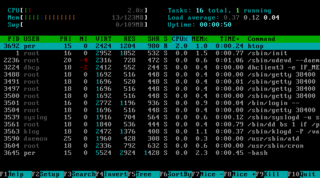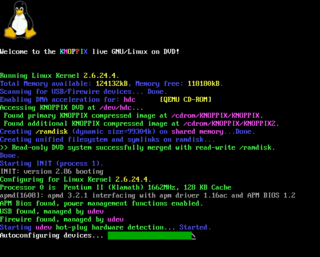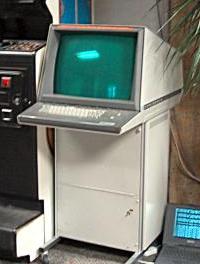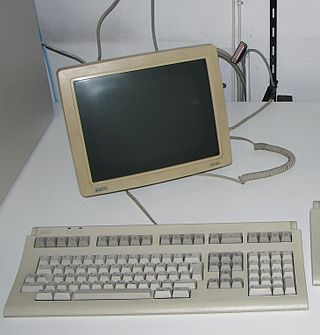
The VT100 is a video terminal, introduced in August 1978 by Digital Equipment Corporation (DEC). It was one of the first terminals to support ANSI escape codes for cursor control and other tasks, and added a number of extended codes for special features like controlling the status lights on the keyboard. This led to rapid uptake of the ANSI standard, which became the de facto standard for hardware video terminals and later terminal emulators.

ANSI escape sequences are a standard for in-band signaling to control cursor location, color, font styling, and other options on video text terminals and terminal emulators. Certain sequences of bytes, most starting with an ASCII escape character and a bracket character, are embedded into text. The terminal interprets these sequences as commands, rather than text to display verbatim.
RT-11 is a discontinued small, low-end, single-user real-time operating system for the full line of Digital Equipment Corporation PDP-11 16-bit computers. RT-11 was first implemented in 1970. It was widely used for real-time computing systems, process control, and data acquisition across all PDP-11s. It was also used for low-cost general-use computing.

A computer terminal is an electronic or electromechanical hardware device that can be used for entering data into, and transcribing data from, a computer or a computing system. The teletype was an example of an early-day hard-copy terminal and predated the use of a computer screen by decades. Starting in the mid-1970s with machines such as the Sphere 1, Sol-20, and Apple I, terminal circuitry began to be integrated into personal and workstation computer systems, with the computer handling character generation and outputting to a CRT display such as a computer monitor or, sometimes, a consumer TV.

The VT220 is a computer terminal introduced by Digital Equipment Corporation (DEC) in November 1983. The VT240 added monochrome ReGIS vector graphics support to the base model, while the VT241 did the same in color. The 200 series replaced the successful VT100 series, providing more functionality in a much smaller unit with a much smaller and lighter keyboard. Like the VT100, the VT200 series implemented a large subset of ANSI X.364. Among its major upgrades was a number of international character sets, as well as the ability to define new character sets.

One meaning of system console, computer console, root console, operator's console, or simply console is the text entry and display device for system administration messages, particularly those from the BIOS or boot loader, the kernel, from the init system and from the system logger. It is a physical device consisting of a keyboard and a printer or screen, and traditionally is a text terminal, but may also be a graphical terminal. System consoles are generalized to computer terminals, which are abstracted respectively by virtual consoles and terminal emulators. Today communication with system consoles is generally done abstractly, via the standard streams, but there may be system-specific interfaces, for example those used by the system kernel.

IBM 5250 is a family of block-oriented terminals originally introduced with the IBM System/34 midrange computer systems in 1977. It also connects to the later System/36, System/38, and IBM AS/400 systems, and to IBM Power Systems systems running IBM i, as well as the Series/1 minicomputer.

The Tektronix 4010 series was a family of text-and-graphics computer terminals based on storage-tube technology created by Tektronix. Several members of the family were introduced during the 1970s, the best known being the 11-inch 4010 and 19-inch 4014, along with the less popular 25-inch 4016. They were widely used in the computer-aided design market in the 1970s and early 1980s.

xterm is the standard terminal emulator for the X Window System. It allows users to run programs which require a command-line interface.

The VT50 is a CRT-based computer terminal that was introduced by Digital Equipment Corporation (DEC) in July 1974. It provided a display with 12 rows and 80 columns of upper-case text, and used an expanded set of control characters and forward-only scrolling based on the earlier VT05. DEC documentation of the era refers to the terminals as the DECscope, a name that was otherwise almost never seen.
WPS-8 is a Word Processing System sold by Digital Equipment Corporation for use with their PDP-8 processors.

The Teletype Model 33 is an electromechanical teleprinter designed for light-duty office use. It is less rugged and cost less than earlier Teletype models. The Teletype Corporation introduced the Model 33 as a commercial product in 1963, after it had originally been designed for the United States Navy. The Model 33 was produced in three versions:

The VT420 is an ANSI standard computer terminal introduced in 1990 by Digital Equipment Corporation (DEC). The 420 is the only model in the 400 series, replacing the VT320. There are no color or graphics-capable 400 series terminals; the VT340 remained in production for those requiring ReGIS and Sixel graphics and color support. The entire lineup of VT300s and VT420 was eventually replaced by the relatively unknown VT500 series starting in 1993.

The Gold key is a computer keyboard key used as a prefix to invoke a variety of single-key editing and formatting functions. Usually located in the top-left position of the numeric keypad on platforms such as the VT100, it is the signature element of a consistent user interface implemented by Digital Equipment Corporation (DEC) across multiple product lines.

The ADM-3A was an influential early video display terminal, introduced in 1976. It was manufactured by Lear Siegler and had a 12-inch screen displaying 12 or 24 lines of 80 characters. It set a new industry low single unit price of $995. Its "dumb terminal" nickname came from some of the original trade publication advertisements. It quickly became commercially successful because of the rapid increase of computer communications speeds, and because of new minicomputer and microcomputer systems released to the market which required inexpensive operator consoles.

The VT520 is an ANSI standard computer terminal introduced by Digital Equipment Corporation (DEC) in 1993 and 1994. The VT520 is a multi-session monochrome text-only terminal with a built-in 14" monitor. The VT510 was a single-session version, while the VT525 added color support and used a separate external monitor.

The VT320 is an ANSI standard computer terminal introduced by Digital Equipment Corporation (DEC) in 1987. The VT320 is the text-only version, while the VT330 adds monochrome ReGIS, Sixel and Tektronix 4010 graphics, and the VT340 adds color.
The VT1000 was a monochrome X Window System computer terminal introduced by Digital Equipment Corporation (DEC) in April 1990. The VT1200 replaced the VT1000 later that year, consisting of a code update and a bump in the RAM from 1 to 2 MB. All of the VT1000 series communicated with their host computers over Ethernet, supporting TCP/IP as well as DEC's terminal-oriented Local Area Transport (LAT) protocol. They also included standard serial ports to allow basic terminal emulation, built into the ROM.

The PDP-8/e was a model of the PDP-8 line of minicomputers, designed by the Digital Equipment Corporation to be a general purpose computer that inexpensively met the needs of the average user while also being capable of modular expansion to meet the more specific needs of advanced user.

The Hazeltine 1500 was a popular smart terminal introduced by Hazeltine Corporation in April 1977 at a price of $1,125. Using a microprocessor and semiconductor random access memory, it implemented the basic features of the earlier Hazeltine 2000 in a much smaller and less expensive system, less than half the price. It came to market just as the microcomputer revolution was taking off, and the 1500 was very popular among early hobbyist users.
















